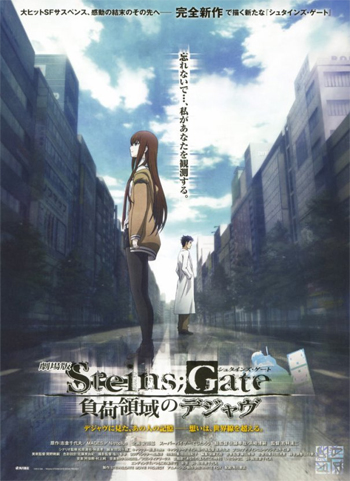
Theatrical poster featuring the main characters. (used under fair use rights to enhance critical analysis)
by Lucas Krejci-Papa
Biblical allegory surrounds us, and for the average American, it inundates the media we consume everyday. Media in various forms heavily features biblical allegory, though many references go almost entirely unnoticed by audiences in the States.
For a pertinent example of the proto-typical contemporary re-imagining of the Christ story, consider the Japanese series “Steins;Gate,” which serves us all well in its highly compelling representations of the biblical tale in a context more accessible to modern audiences.
The story follows protagonist Okabe Rintarou, a young graduate student and brilliant physics lab chief in his spare time. He’ll be serving as both our redeeming Christ Figure, and as the Original sinner, by the time this story is told.
Indeed, just like the biblical ancestor of humanity, Okabe unknowingly takes up the mantle of Adam, with good intentions, in being tempted by Makise Kurisu, his girlfriend and lab assistant portraying the role of Eve (and later Peter), to design peerless time-travel technologies with which he hopes to enrich and enlighten mankind. The knowledge of time travel substitutes for the classical fruit from the tree of knowledge.
The experiment is a great success, yet yields untold horrors. Humans quickly prove themselves unable to responsibly manage the vast possibilities of time-space, and the future, swallowed by hypertime, suddenly shows nothing but nightmarish dystopias, catastrophic natural disasters, and all-consuming wars.
It befalls our virtuous hero, in all his infinite wisdom and perilous humanity, to rescue mankind from time travel by ‘unmaking’ the concept, thus undoing the original sin, which is only achievable by bearing the burden of all mankind’s wrongdoings. As he and Kurisu venture through every possible iteration of the same three days, experiencing every nightmare and disaster wrought by the hands of man, he confronts directly the hell created by humankind.
Three remarkably familiar days, during which our cast is remarkably familiarly occupied, as they are clearly entrapped by the maws of eternity itself.
They are aided only by a small contingent of disciples (Lab members) at their disposal, and even fighting through the corrupting influence of their Judas figure, who would see them all sold to shady government figures, and the secrets of time unwound.
Okabe and Makise overcome this betrayal, and the world itself even overcomes the nature of infinity, but this is a process that robs our hero of his very humanity.
Stranded between his human nature and some enlightened, ascended rebirth that appears beyond the fringes of time and space, Okabe represents Jesus. Figuratively and also literally reborn, this triumphant Christ figure then absolves mankind of wrongdoing, freeing them from the treacherous grips of the original sin.
Forgive them father, for they do not know what they do.
A familiar tale, having been told time and time again, is re-imagined here as a contemporary science-fiction drama. Fascinatingly, however, the inherent story within only grows more and more impactful with its modernized portrayal, and, I imagine, only stands to teach us all new lessons even as we process it for the umpteenth time.
After all, this is the prime function of Biblical allegory today.

